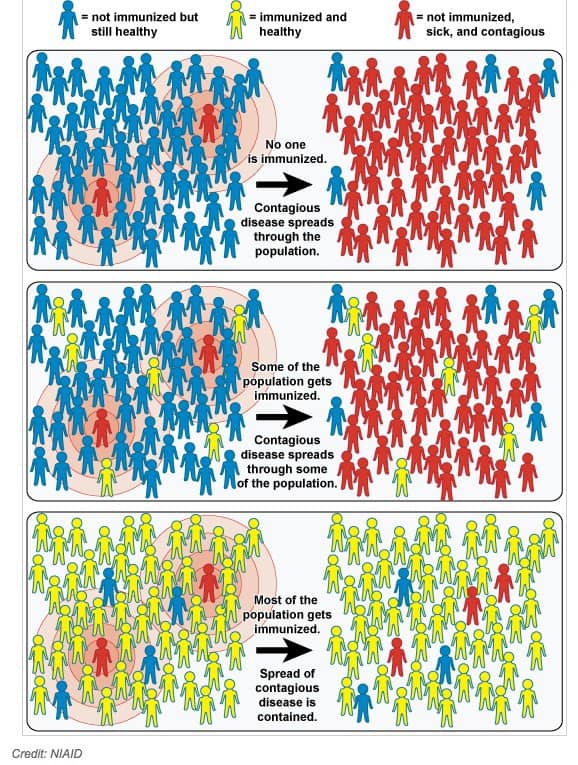There are two snark-tropes I love when it comes to a zombie apocalypse:
- You don’t have to run faster than the zombies, you only have to run faster than the guy behind you.
- You are not Rick Grimes.
That first one is pretty self-explanatory, that second one – it’s the problem that we, especially those of us in the United States, have. We’re the heroes of our own action movies. If there’s an apocalypse, with or without zombies, we’re going to be among the survivors, and more than likely, we’re going to lead the survivors. Us. Because…we’re us, right?
In reality (and of course, depending upon the type of apocalypse)…yeah – that’s not likely to be the case. In any zombie movie, the survivors are often just the lucky ones, not the prepared ones.
I think we should take a lesson from that here in our COVID-19 world.
Along with the “it’s just the flu” talking point that’s being advanced (COVID-19 is not “just the flu”), the “we just need to get to herd immunity and we’ll be fine” thing bubbles up a lot, and is probably going to start coming up more as states start to re-open. While on the surface, that’s a terrific idea and a great goal, it’s not going to happen a) quickly, and b) without tremendous, tremendous human cost. And of course, there’s a non-zero chance that you may be part of (b) – that tremendous cost.
What’s Herd Immunity Anyway?
Herd immunity is something that’s in the pandemic lexicon because, unfortunately, it’s come back into discussions and news cycles as the anti-vaccine movement has taken off. If you think back, the term really hit its stride as measles was showing up in larger and large pockets back around 2015 and onward. That was when a measles outbreak was traced back to exposure at Disneyland.
And of course, most recently, it was Boris Johnson’s big idea for the UK, until it was pointed out that somewhere around 250,000 people would die on the road to get there. That changed some minds, although, according to a recent report in The Independent, despite having been infected and having been hospitalized in intensive care himself, Johnson is still kind of thirsty for the idea.
So – definition: herd immunity is a concept which describes a condition within a population where enough of the individuals are immune to a disease so that the disease cannot spread within the group. The immunity can come from either being infected and recovering (with the assumption that the recovered individuals will be granted immunity by virtue of being infected and recovering) or the immunity can come via vaccination. As a result of herd immunity, the larger, or ideally, the entire population – including those who are not immune or cannot be immunized – are protected because the disease cannot find hosts into which it can spread.
There are several terrific resources on herd immunity, and if you are looking for more on the definition or further understanding, I’d recommend the always excellent Hank Green at SciShow:
Or, for the more R-rated, got-no-time-for-politeness, Penn and Teller…
Or just as a picture:

And for a full rundown on herd immunity from a variety of experts, click here.
Herd Immunity’s Moving Pieces
Let’s get ready to get to the numbers.
As explained in our earlier article herd immunity is based on the R0of an infectious disease, (on average, how many un-infected individuals a carrier of a disease will infect). Based on the R0 of SARS-CoV-2, (somewhere between 2 and 5), herd immunity would require a minimum infection rate of 60-65%. Take your population that you want to have herd immunity, infect 60-65% of them with the virus, and bingo. According to the model, you’ll have it, and the virus won’t be able to spread within that population.
But getting to that point will cost lives because a current, conservative estimate of the virus’s fatality rate is about 2%. That means that 2% of the people who are infected die – straight out, or from co-morbidities. Yeah, and that 2% is probably underreported/undercounted, but let’s not worry about that right now. Let’s say a 2% fatality rate and go from there. [Edit for clarification – I used 2% based on John Hopkins’ numbers, current as of 5/3/20 of the case-fatality rate, that is, deaths per 100 people with confirmed infections. As of this writing, the case-fatality rate for the US was 5.9%. 2% is conservative, and data is always rolling in that either bring that number down in local areas or lifts it. Case-fatality was used here since the achievement of herd immunity requires the members of a population to be infected, rather than the deaths per 100,000 people, which included both infected and uninfected individuals. As always, the numbers you use may differ, and may be lower or higher.]
Before the math – some other thoughts. This idea of herd immunity being achievable by just getting everyone sick is great and all – a lovely dream. We all get the sniffles and get over it, and move on, just like we were you know? It’s like what happened that time when we did the same thing with…
Yeah…
We haven’t. We’ve never achieved herd immunity via population infection. If we had, its proponents would be pulling up charts and historical reports and data to sell the idea, rather than just advocating for the idea and, in many cases, yelling the words “herd immunity” louder and louder to drown out anyone else. Or, in some horrific cases, vocally embracing the idea that reaching herd immunity will kill off the old and the sick – and you’re okay with that. Yeah, that was done. Click the link.
Any virus that we have – or convinced ourselves we have – herd immunity with, we’ve had a vaccine backup. We did not/do not achieve kinda/sorta herd immunity to chickenpox because there was that one time that everyone in a country or on the planet got chickenpox. It’s the same with measles, polio, and mumps. Yeah – some people get sick, and some people catch it every now and again, but a lot of us are vaccinated against the diseases, which is why the immunized generally don’t get them and can’t spread them (although there are cases of diseases coming back and infecting immunized groups). We have what we like to believe is some kind of effective herd immunity.
I use waffle words about herd immunity because the antivaxxers have started messing up the kinda/sorta effective herd immunity we had against things like measles (remember the Disneyland outbreak in 2015?). Hey – and polio and mumps – never heard of anyone who had those, right?
The fewer people vaccinated against those diseases means the greater the chance we’ll lose herd immunity and start to see outbreaks of both of those…and other diseases with regularity. Mumps is already coming back in some areas, and polio is always knocking at the door.
But there’s that big assumption that comes with herd immunity via infection – that infection by SARS-CoV-2 will grant immunity to reinfection. We don’t know that yet. While virology and immunology suggests that infection should confer some level of immunity, the data and evidence on this aspect of the disease is murky at best. There are multiple reports of individuals who’ve recovered from SARS-CoV-2 still shedding viral fomites and testing positive for the virus, or possibly becoming reinfected, or maybe not. Until the recovered-reinfected picture is cleared up, the effectiveness of herd immunity via infection is uncertain at the best, pointless at the worst. It’s unlikely, but not 100% that nature could kick us in the ass on this one and not give people full immunity after infection, which stops the herd immunity idea cold.
And of course, remember – we’ve never achieved herd immunity without immunity coming from vaccines. This is a novel coronavirus. There is no vaccine. There’s a lot of work and well over a hundred candidates, but there’s no vaccine to grant immunity to the bulk of the community who would probably prefer to gain immunity via a shot, rather than an infection that carries a chance of hospitalization, a long recovery, possible lifelong complications or possibly death.
Gideon Meyerowitz-Katz, an epidemiologist in Sydney Australia recently said that when he was seriously asked about achieving herd immunity to SARS-CoV-2 by a journalist, he laughed, thinking that the journalist was joking. They weren’t, and he was stunned.
Why isn’t he talking about Rick Grimes yet?
Application of Herd Immunity in a Community – Local Thoughts
I’m a high school science teacher. So when I hear the “herd immunity” argument come up around me, I instantly go to my school as my “lab” where the experiment will be conducted.
Let’s say a community – under really poor leadership – goes all “damn the torpedoes, full speed ahead” on herd immunity, pointing at say, Sweden where a nation-wide herd immunity experiment is underway with (your mileage may vary) horrible results, which will probably scar that country’s psyche for a generation. Spoiler – Sweden is not doing as well as you may have heard, or their politicians are claiming.
Okay – so if we want to go this route, say, in schools, there will be people who will refuse to be infected themselves, or refuse to let their kids be part of the herd immunity experiment for whatever reason (these would be the flat-out anti-vaxxer crowd, or immuno-compromised individuals or high-risk folks, or whoever just doesn’t want it). What do we do with them? Do we forcibly expose everyone in a community to the virus? You need 60-65% to be not just exposed but infected with the virus for this to work. Positive test and all. What if 50 or 60% of your group says “No, man. Not me.”
Do you jab them or mist them anyway? Call in the authorities, make it illegal to say no to infection if you are healthy enough? Enforced infection in the name of freedom?
Wait – why isn’t he talking about Rick Grimes. He is really burying that reference…
Infecting Your Friends and Students with SARS-Cov-2!
Okay, let’s (finally) talk numbers. The calculations are easy to do, and fun for entertainment at a Zoom party if you want to bring the entire room down.
Take the chunk of people you want to have herd immunity. For example, I’ll use my school district. It’s a sample that I have a vested interest in “getting back to normal.” We have about 55,000 students, and about 7,200 staff/faculty/admin. Those numbers are most likely outdated and slightly low. Don’t worry, it will be horrifying anyway, even with low numbers.
Let’s do this herd immunity experiment with imaginary Swiss precision, and only infect *exactly* {chef’s kiss} 60% of the population in question. That will do it, right? We want our district to have herd immunity.
62,200 x .6 = 37,320 need to be infected.
No, I’m not sure where the other 40% (the anti-vaxxers, immunocompromised, etc) would be kept in isolation. This is a silly example anyway but just go with me.
At the current rate of 2% (probably a low-ball estimate – and higher than the flu, but it is what it is) dying:
37,320 x .02 = 746 dead.
Doing this without Swiss precision and we just say, hell with it – let’s infect everyone, then that’s:
62,200 x .02 = 1244 dead.
Since this is a public school district we’re talking about, we do our best, but on the whole public school districts aren’t known for doing anything with anything remotely approaching Swiss precision. Let’s say for argument’s sake that the range of people dead in our herd immunity experiment for this district will be somewhere between 750 and 1200.
That’s a lot of funerals that the superintendent, administrators, and teachers will have to go to – without masks or social distancing, because, presumably the experiment in herd immunity will be continuing while we’re burying people.
The latest hospitalization rates are around 4% of the infected (still higher than the flu), so that’s somewhere between:
37,320 x .04 = 1493 and
62,200 x .04 = 2488 that will need to be hospitalized.
The number needing to go into the ICU will be less than that, obviously, as many of the hospitalized will recover.
I’m not calling my two local giant hospitals and asking them how many beds they’d have available. I figure they have better things to do than talk to me. Maybe we can use the gyms in the schools as emergency hospitals/clinics. It would be a little morbid to have fellow students suffering and a few dying while classes are going on, but it would keep these experimental victims out of the hospitals – which will have their own problems, because well…
You see the problem, right? My petri dish – a school district – is part of a larger community. Each individual in the district that is infected will infect somewhere between 2-4 other people (that’s the R0 for the virus) – and no…no masks, hand-washing, or social distancing when students and teachers go home from school. We want everyone to get infected. We want this herd immunity to cover our whole community.
As with everything on thescienceof.org, you can put your own numbers in and do your own math for a small group or your whole community, but however you do it, I don’t think your community has enough funeral homes, crematoriums or graveyards for the spike in business they’re going to see.
Real Talk
As I said, I’m a high school science teacher. I have students for whom this has not been ideal – and that’s putting it lightly. I agree that something needs to be done. I just don’t see some magical herd immunity as being “the” solution that somehow, even though we’ve never achieved it without vaccine support before now…will work this time because…I don’t know? Insert whatever reason you believe it will work here. Seriously – I’m open to anything.
Full disclosure – I’m not sure what I’m missing. I’m not an epidemiologist or have a degree in public health. I have a significant chunk of post-graduate work (ABD for my Ph.D.) in physiology and pharmacology, but at the end of the day, I’m just a high school science teacher who tries to live what he teaches his kids to do – read a lot, ask smart people dumb questions and try to understand shit that’s complicated.
Seriously – if you see the cracks, tell me where I messed this up, and I will totally and humbly fix and correct it and point out where I was wrong, and shut my mouth.
But the thing is – I think I’m at least kind of right on this. The idea of herd immunity is a risky, risky way to go, and I’d just like for its advocates to acknowledge from the outset that it will cost lives. Part of the reason for this article existing is that I really fear this idea of herd immunity is going to be shouted louder and louder as a magic-ish bullet that will fix this problem.
For those who want to push this idea of herd immunity, even now, after reaching this point in the article, please, just be intellectually honest from the start, and begin your call for herd immunity with the Lord Farquaad quote:

Lord Farquaad, keeping it real. (c) Universal Pictures
… and then go from there. Be honest with the people you’re talking at, some of whom will most likely die if we follow this path, 100%
It’s the same way I want people saying “it’s just the flu” to acknowledge from the outset that they’re cool with at least double the deaths attributed to “the flu” in a given season. We’ve seen more deaths from COVID-19 in less time than we see from the flu in an entire flu season. COVID-19 is killing at a higher rate than the flu. It’s not “just the flu.”
But anyway – if you’re going with either, just up front, admit that you’re cool with a lot of folks dying.
I’m Only Reading This Because You Mentioned Rick Grimes…
Right – sorry. It was mostly just to get you to read this article. But to get back to the earlier mention, you’re not Rick Grimes in this story. There’s a solid chance that you’re a zombie.
That is, there’s a greater than zero chance you could be one of those people you’re presumably okay with dying as mentioned above if you’re advocating herd immunity for SARS CoV-2. I think for a lot of people, their arguments take on a different tone when they start counting themselves among the victims, rather than the survivors.
Just try running that through your head: “I recommend this course of action, even though it may kill me.” That’s rough to work through, and no, I don’t buy for a second that people who are advocating for herd immunity or running with other risky approaches full-tilt are thinking through what they’re saying, deep down. Next time you hear someone say it, ask if they’ve finalized their will, and settled all of their affairs – you know, just in case. I’m betting they haven’t.
Historically, when individuals push for plans akin to herd immunity, you’re supposed to die. They’re supposed to live. But deep down, you knew that, right?
Oh, and going way back to an earlier point – what if Nature is messing with us royally on this, and there is no effective herd immunity that we can reach via infection, but we push forward anyway? Those people that died in a community…they died for…what again? We just say, “whoops” and move on, carefully making our way out of the cemetery with all the freshly dug graves?
Edit: 5/3, 6:00 pm, clarified and added… “which is why the immunized generally don’t get them and can’t spread them (although there are cases of diseases coming back and infecting immunized groups)” Some diseases with vaccines or infection-based immunity, such as mumps (above) measles and whooping cough have been shown in recent years to infect those who had previously received vaccines or had the disease. The reasons are unknown in some cases, or due to advances in vaccine science since the individual had been immunized. The latter is something that was seen with the measles outbreak last year, where individuals vaccinated against the disease with two doses after 1967 should be vaccinated for life, while those who were vaccinated with the “dead” version of the vaccine between 1963 and 1967 should be re-immunized against measles, according to the CDC. Neither vaccines nor infection with a given disease is 100% in regard to granting immunity.







